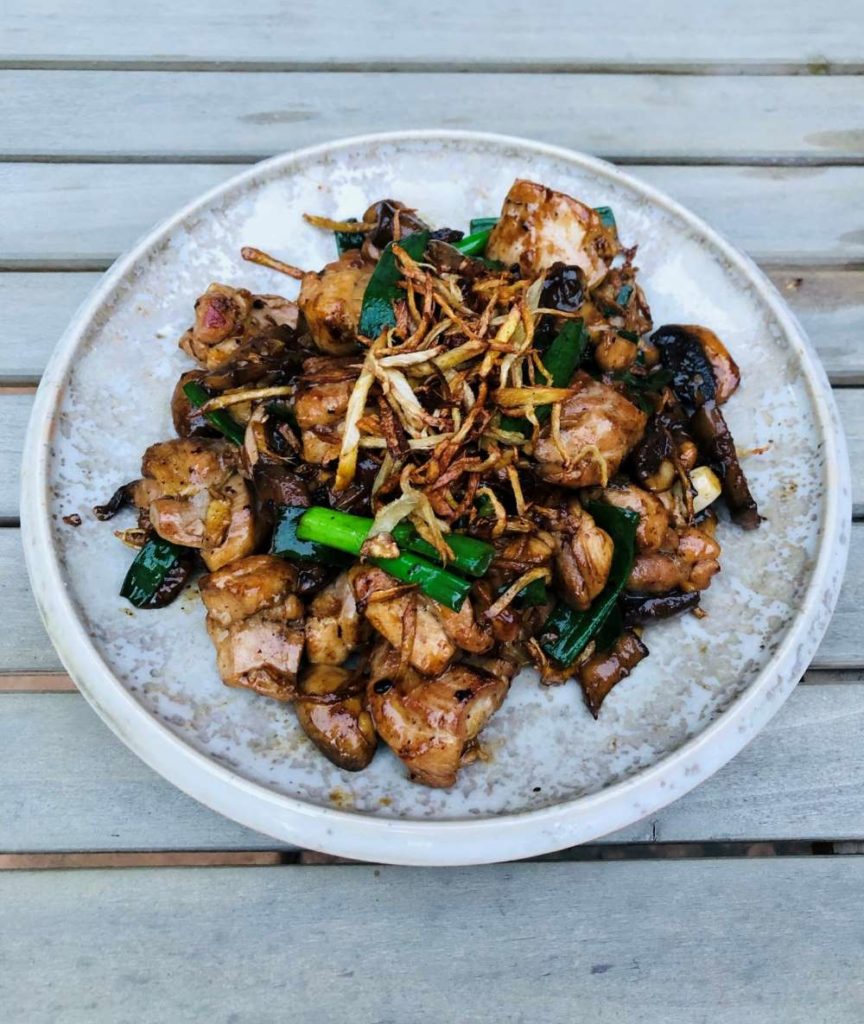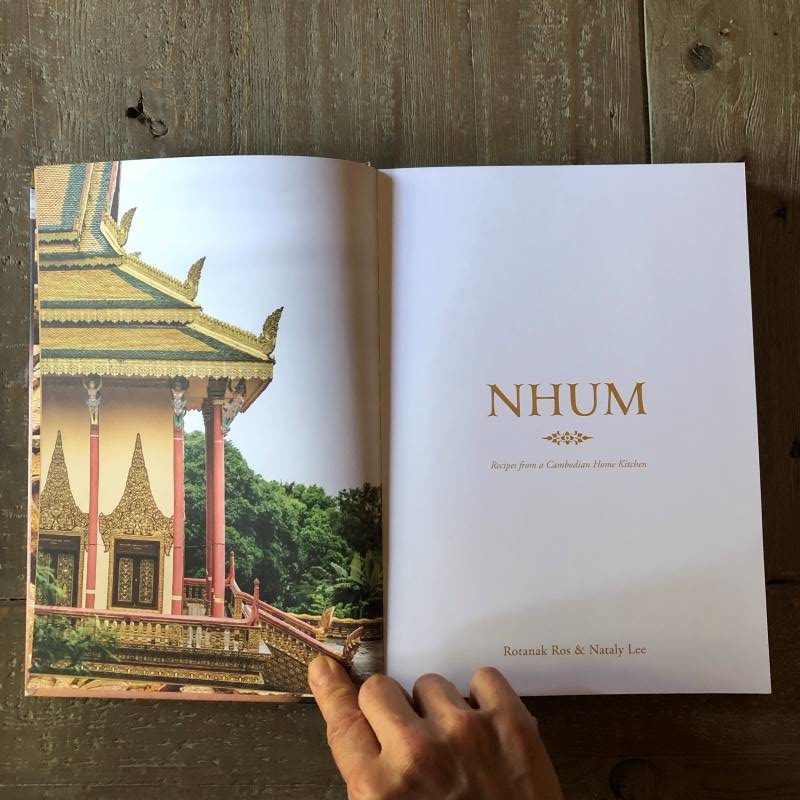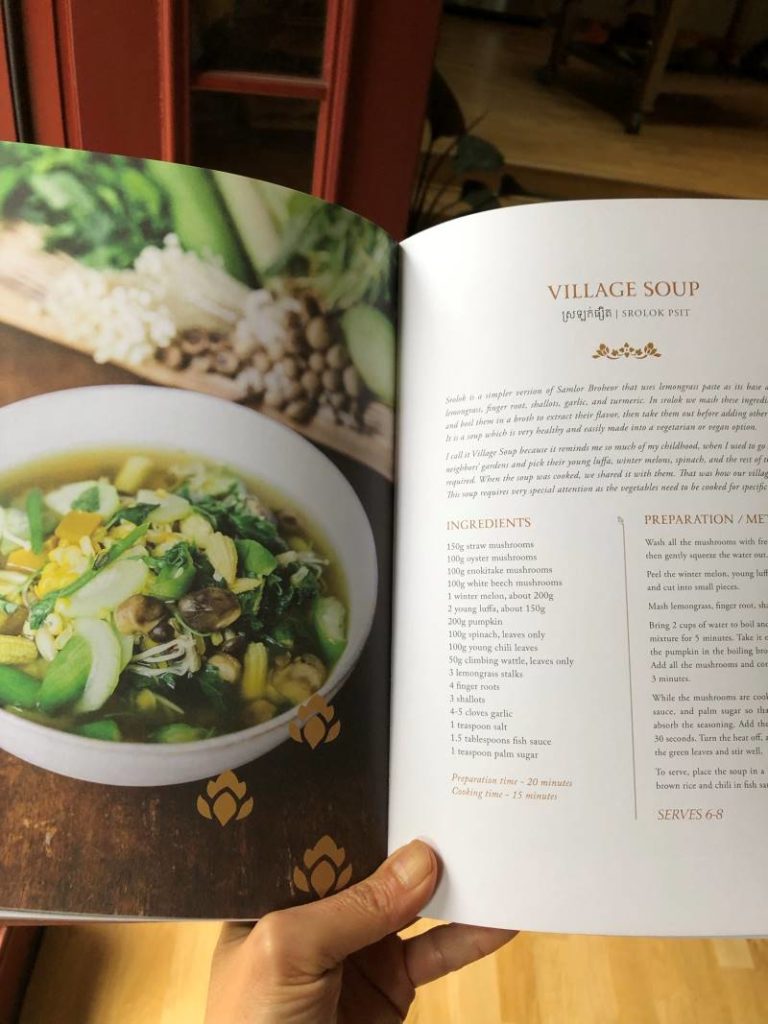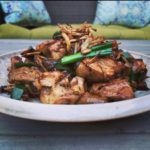
Despite Cambodia being Vietnam’s neighbor, Cambodian cuisine is hardly mentioned in food savvy circles. On my shelf is a single cookbook from long ago. I’ve been to only a handful of Cambodian restaurants and didn’t gain much knowledge aside from the fact that their kuy teav inspired Vietnam’s hu tieu Nam Vang, one of my favorite noodle soups. Without doubt, I’m eager to learn more about Cambodian cooking.
Given the country’s tumultuous history, it’s understandable that writing English language cookbooks hasn’t been a priority on many people’s minds. But, I recently heard about Nhum, a 2019 cookbook by two women, chef Rotanak Ros and photographer Nataly Lee. Rotanak resides in Phnom Penh.
Their book, Nhum: Recipes from a Cambodian Kitchen, was self published under Ros’s imprint. It’s stylish and produced with lots of heart and opinion. They aim to preserve key traditions and amplify the flavors of their heritage. I learned about Ros and Nhum through a coincidence. Ros and I were both included in a Taste of Home list of 10 famous Asian chefs changing the way people eat.
Nhum is low key and not well known, so purchasing online was easiest for me. I began perusing the Cambodian cookbook as soon as it arrived.
Cambodian Heritage, Culture, and Wellness
Ros is out to spotlight the healthiness inherent in Cambodian cooking. The front section of the book holds a wealth of information on fruits, vegetables, herbs and spices. English, Khmer (Cambodian) script, and Romanized Khmer are presented. The recipes mostly serve 6 to 8 and tend to employ a fair amount of animal protein. That's not a deal breaker since ingredients may be scaled down by half or so. Similar to Vietnamese cooking, there are lots of raw vegetables and herbs involved.


I adore the rustic beauty of the food and unvarnished, matter of fact quality of the recipe writing. For example, of course you’ll be making rice often so that you’ll get enough dried rice from the bottom of the pot for making crispy rice crackers. I don’t likely make bai kdaing pises but I’ll now know of it. Recipe introductions tend to be brief but where they run a bit longer, they offer interesting cultural insights and home cooking. I wish there was more of that so the reader may have a deep sense of the context. That said, there’s plenty to read between the covers.

Cambodian-Vietnamese Connections
Recipes such as Cambodian-style shaking beef, sizzling rice crepes, beef in la lot (wild betel) leaves, and rice paper salad rolls reflect the porous, shifting border between Vietnam and Cambodia. From the ninth to the fifteenth century, the Khmer Kingdom included most of Southeast Asia and parts of what’s now Vietnam. In the central region of Vietnam near of Hoi An, there’s a wonderful Khmer archeological site: My Son, a UNESCO world heritage site.

What surprised me was Ros and Lee’s chapter of caramelized khor recipes. They are basically like Vietnamese kho dishes of simmered proteins braised with bittersweet caramel sauce. There are Laotian and Thai kho-style recipes for eggs and pork belly but I didn’t know that the Cambodian repertoire was more expansive. Totally cool! Nhum recipes call for caramelizing palm sugar, which I’ve done in recipes like this Viet pork belly in caramel sauce.
Adapting Classic Cambodian Chicken with Ginger
Wanting to explore the flavors of Nhum, I chose a classic -- cha khnei sach moan, chicken with ginger. It's loaded with ginger so it's full of health benefits. When cooking from recipe books produced overseas, bridging ingredient differences is often required. For example, the original recipe called for 500 grams (over 1 pound) of ginger, which in America would a lot of heat for the two-kilo (4.5-pound) chicken used. I wondered what kind of ginger Ros and Lee used in Cambodia.

Reviewing the book’s ingredient section, I realized that their ginger is young ginger. In the States, it's a seasonal item that’s relatively hard to find. I use young ginger for Japanese-style pickles and know that it’s heat level is pretty low. In fact, you can eat lots of it raw, as is done in northern Thai and Lao grilled sausages. Given that, I could use a lot less of the mature ginger and still get a gingery bite. (I prefer peeling ginger with a sharp swivel peeler over a spoon.)
Secondly, I wanted to go low-meat because that’s how I cook these days. A whole chicken typically yields about 4 or 5 meals for our family of two! Not wanting to hack at chicken parts, I opted to use boneless skinless thighs. Furthermore, I added mushroom (like I did for the Thai-style chicken, mushroom and basil recipe) for meatiness. To match the chicken's chunkiness I tore the mushroom.

Scaling back on the seasonings was easy because the original recipe was unfussy. What I came up with was this recipe for you to use. It deliciously retains the flavor of Nhum’s original but with boneless chicken, mushroom chunks, and lots of ginger. Those are ingredients obtainable from a standard grocery store. For encouragement, I made this video of making the dish:
There’s so much to learn in a book like Nhum so I hope you get a copy and dive in! In fact, since nhum means "eat" in Khmer, take it all in. Eat this up and more.
Cambodian-Style Chicken and Mushroom with Ginger
Ingredients
- 1 pound boneless skinless chicken thighs
- 8 ounces large cremini mushroom
- 4 ounces ginger, peeled and cut into sliver-like matchsticks
- 5 cloves garlic, finely chopped
- 3 medium green onions, cut into 1 ½ to 2 inch lengths
- 2 teaspoons brown or palm sugar
- 1 tablespoon oyster sauce
- 1 ½ teaspoons soy sauce
- ½ teaspoon fine sea salt
- 3 tablespoons neutral oil, such as canola or peanut
Instructions
- Cut the chicken into 1 ½-inch chunks, making the thinner center pieces a little larger than the thicker ones on the ends. Set aside.
- Snap off the mushroom caps, then tear each into 2 or 3 pieces. Pull the stems in half lengthwise. Set both aside with the ginger, garlic, and green onions near the stove.
- In a small bowl, stir together the sugar, oyster sauce, soy sauce, and ¼ teaspoon salt. Taste and make sure the flavor is pleasantly balanced between salty, savory, and sweet. Adjust as needed. Set this seasoning sauce near the stove too.
- In a large wok or nonstick skillet, heat the oil over medium heat. When gently rippling, add the ginger. Cook for 3 to 5 minutes, stirring frequently and adjusting the heat down, as needed, to avoid scorching, until the ginger is golden brown; stop a bit short of deep brown because the ginger will continue cooking after the heat is turned off. Use a slotted spoon to transfer the ginger to a plate, leaving the oil in the pan.
- Reheat the wok over medium heat and add the garlic. Constantly stir and let it fry for about 20 seconds, until aromatic, then raise the heat to medium high and add the chicken. Cook for 1 to 2 minutes, until the chicken no longer looks raw. Then add the mushroom, seasoning with about ¼ teaspoon salt. Keep stir-frying for a few minutes, until the mushroom pieces are soft and glistening. If things look dry, splash in a little water.
- When the chicken is nearly cooked through, stir the seasoning sauce then pour into the pan. Cook, stirring swiftly to incorporate the flavors. When the sauciness has mostly disappeared, add nearly all the fried ginger, stirring to combine and distribute well. Add the green onion and cook briefly to wilt, then turn off the heat and transfer to a serving plate. Crown with the remaining fried ginger and serve immediately.


















Alison Rowe says
This gives insight not only into Cambodian food, but also into the care you take as you process recipes to make them more accessible to us. I appreciate all your work in sharing the flavors and joyfulness of S.E. Asian cuisine. Thank you!
Andrea Nguyen says
Thank you, Alison! I try because I'm just as curious and interested as you are!
Kris Hoover says
Thank you for featuring a recent Cambodian cookbook - I only have one & it was a fundraiser from years back; thoughtful but simplified for mainstream grocery stores.
Cambodian food is SO delicious! We're lucky here in the Minneapolis area to have Cambodian restaurants (my current favorite is Cheng Hang in St. Paul) & excellent produce from our large Hmong farming community.
It's heading for a record-hot summer here, so we'll be enjoying the wealth of Cambodian salads & other cold dishes!
Kris Hoover says
Sorry typo in my first post! The correct spelling is Cheng Heng. Spellcheck 🙄
Andrea Nguyen says
No problem. I'm sure Cheng Heng appreciates your spellchecking!
Gillie says
Hello! I have a question about fish sauce. The last decade has found me getting ever more allergic to shellfish and fish. It started with shrimp, and now fish sauce makes me ill. What could I use in exchange for the fish sauce in recipes? I adore Vietnamese food, and looking at a future without any Vietnamese food forever is breaking my heart.
Andrea Nguyen says
I'm sorry to hear that Gillie. You could try a vegetarian fish sauce. This is some information on it that I wrote up:
https://www.vietworldkitchen.com/blog/2019/07/vegetarian-fish-sauce-buying-guide-and-recipe.html
I hope that's helpful. Substituting soy sauce doesn't do the trick in most cases.
Gillie says
Vegetarian fish sauce, who knew!?! Amazing. Thank you so much for the link to that article!
I will at H-Mart the next time I go shopping. And maybe give a look see at Amazon. And if all else fails, I'll give your recipe a try.
Andrea Nguyen says
I'm sorry to hear that Gillie. You could try a vegetarian fish sauce. This is some information on it that I wrote up:
https://www.vietworldkitchen.com/blog/2019/07/vegetarian-fish-sauce-buying-guide-and-recipe.html
I hope that's helpful. Substituting soy sauce doesn't do the trick in most cases.
Gail Lopez-Henriquez says
Andrea- I've been to Cambodia a couple of times and have a few Cambodian cookbooks, and my favorite dishes are the ones with a large quantity of crisp brown julienned ginger. I find that the crisp frying reduces the heat of the ginger quite a bit. Although 500 grams does seem excessive, in my opinion your recipe looks like it doesn't have enough. The ginger should be almost like a vegetable component of the dish, not just a seasoning. BTW this is also a dish which makes good use of mushroom soy sauce, if you have it.
Winston A Edgeworth says
Great website, I like your work very much, come on! https://www.oilpressstore.com/